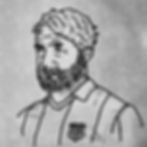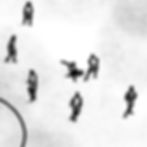Free Chapter: The Iceberg
- Bob Bjarke
- May 10, 2023
- 6 min read
In honor of Sergio Busquets' announcement that he's leaving FC Barcelona at the end of the 2022-23 season, I'm giving away the chapter of Non-Goals that goes deep on his style and legacy. Enjoy!
The Iceberg
One of the most significant passes of Sergio Busquets’ career was also one of his shortest. Hovering near the center circle, Busquets took three steps forward into open space to make himself available for a pass from his teammate, the great Lionel Messi. As soon as Busquets received the pass, he stopped and waited for Messi to run around him, using his own body as a screen. Busquets then gently rolled the ball into Messi’s path so that it was just in front of his favored left foot—the ball only traveling about the length of its own diameter. Messi gathered steam and neither his defender, who had been screened out by Busquets’ positioning, nor Busquets’ defender, who was late covering, could slow him down. Four more defenders and a goalkeeper stood between Messi and the goal, and Messi beat them all. Neatly dribbling past the first two defenders in his way and flying past the third, he rounded his way toward the goal and rolled the ball past the sprawling keeper as the fourth defender tried to get a foot on the ball and missed. Together, Messi and Busquets turned what was essentially a 2-on-7 into a game-clinching goal for Barcelona against their biggest rivals, Real Madrid.
In explaining his “Iceberg Theory” of writing, Ernest Hemingway once said, “If a writer of prose knows enough about what he is writing about he may omit things that he knows and the reader, if the writer is writing truly enough, will have a feeling of those things as strongly as though the writer had stated them.” Rather than flaunt his vocabulary and mastery of the English language with complex, decorative language, Hemingway believed that a story could actually be stronger if an author intentionally omitted elements that could easily have been included. These omissions ensure only the most “true” information appears on the page, allowing the reader to feel or imagine the subtexts lying below the story’s surface. With this approach, and through his signature use of simple and plain language, Hemingway became one of the most distinctive writers of the 20th century.

Sergio Busquets’ expertise lies deep below the surface of the game.
To Hemingway, it was crucial that the writer understood his or her subject matter completely. This understanding allows the writer the freedom of telling the story efficiently, letting the reader absorb the truth and paint their own picture through the few carefully chosen words on the page. The power of an iceberg lies not in just what appears on the surface.
Soccer is full of players that perform at surface level. These players create moments that are impossible to miss: goals, penalties, feats of superhuman athleticism, post-goal shirt removal, et cetera. The Mbappes, Salahs, Haalands, Son Heung-mins of the world command attention. Their speed and movement, their ability on the ball, the frequency at which they demand slow-motion replays and closeups from camera crews make their presence on the field utterly conspicuous. Their strengths and interests are visible to any viewer, and they fill their time on the ball with every trick in the book: stepovers, fakes, dribbles, hesitation, acceleration, Cruyff turns, Ronaldo chops. Their brilliance lies in the visible realm. The list of these players is long and reads like a greatest hits collection of the last 20 years, from “Aguerooooooo!” to Zidane.
But there’s a much shorter list of players whose genius lies below the surface of the water, deep underneath the frozen, fractured peak, reaching so far down it’s almost impossible to see without pressurized cabins and depth-rated lights. These are players with impeccable technical skills that they appear to not actually use on a regular basis. Players with body shapes one might not associate with elite athletes. Players that have made careers of behind the scenes non-goal craftsmanship, churning out spectacular moments that you might miss if you don’t have your spyglass at the ready, looking beyond the surface for something lying deeper.
At the top of this depth-dwelling list is Sergio Busquets. Born in Barcelona and belonging professionally only to FC Barcelona during his long career, he is a study in consistency. A master of efficient movement, an unrivaled anticipator, and unquestionably the slowest guy on the field at any given time, Busquets' limited physical gifts require heightened mental and instinctual performance. Like a bat maneuvering through echolocation, Busquets has become one of the best midfielders of his generation as an archetypal under-the-surface player—anticipating and intercepting opposition passes with tactics that aren’t always visible to the naked eye.

Would Hemingway have displayed the “grace under pressure” he so admired had he joined the Barcelona midfield?
Almost everything Busquets does is unremarkable at first glance. For example, most players use their skills on the ball to get past an opponent and move toward the goal; Busquets is more likely to use his limited but effective repertoire to escape pressure and find space moving backward or sideways. While many players want the ball so they can carry it forward until they’re forced to give it up, Busquets wants the ball only so he can deliver it safely to someone in a better position. His instinct and experience lead him to use the sparest of language when others would indulge in paragraphs of ornate description or flowery dribbling. Messi’s goal mentioned above was brilliant, but it was anything but an individual effort. It was made possible by the iceberg on the field. So many other players would have engaged in a thesaurus of movement, attempting to fill the page with their own soccer logorrhea. Busquets knows his subject matter so well, he’s free to present his ideas in the most delicate, elegantly crafted stories in contemporary soccer—revealing only the truth and allowing the viewer to absorb and enjoy the result.
Playing as a “pivot” player in Barcelona’s three-man midfield, Busquets is responsible for defending his defenders. Playing centrally, Busquets stops attacks before they have a chance to begin, but not by obvious physicality, strength, or speed (his only physical gift is a pair of abnormally long legs, which he uses primarily for interception). Rather, Busquets relies on years of experience playing at the highest level to position himself in the right area of the field before disaster strikes. This honed sense of anticipation gives Busquets an edge most players don’t have. And in his role, this edge is much more valuable than a high top speed or powerful physicality.


Busquets makes two tackles in quick succession. Years of experience not pictured.
This style of play won’t often make a highlight reel, but it is essential to the style preferred by Barcelona and the Spanish national team. A style which, over the last 15 years, has raked in an unprecedented amount of success. The Spain team was the first to win three successive major championships: the 2008 Euro, the 2010 World Cup, and the 2012 Euro, with Busquets playing major roles in 2010 and 2012 (including every minute of those tournaments). For Barcelona, he’s won every imaginable trophy multiple times, including three Champions League and eight Spanish La Liga titles.
In the example above, Busquets anticipates his way to two tackles in quick succession, using his unusually long legs to win the ball not once but twice. This deep understanding of the game allows Busquets to omit surface-level defensive histrionics. He doesn’t need to sprint and catch up to an opponent to win the ball from behind, he’d rather put out fires at the first sign of a spark. This kind of defensive play also becomes the beginning of his team’s attack. By winning the ball back quickly and high up the field, Busquets can keep Barcelona in a good position, ready to strike. This kind of defense-to-offense play is a fundamental non-goal. Blink and you might miss it, but the impact is often seen in the actual goals that come as a direct result.
Rarely has a slower player beaten so many faster players while on the ball. Busquets is a man without a “turbo” button, so he uses other players’ speed and ambition against them. It often happens like this:
A Barcelona player passes the ball to Busquets.
An opposing player sprints to pressure Busquets before he has time to control the ball.
Before he receives the pass, Busquets positions his body so that it appears that he’ll move to his right.
The defender approaches quickly, enthusiastically believing he’ll steal the ball from the slow-moving Busquets.
With one simple and elegant touch of the ball, Busquets plays the ball to his left—a minimalist maneuver into space that evades the defender and gives him time to begin an attack, leaving the overly-aggressive defender in his wake.

A typical Busquets slow-motion change of direction.
It’s not flashy. It’s not obviously impressive, but it’s Busquets. Many of the things one expects of a soccer player in 2022—running around at high speed, flashy footwork, jumping high into the air, a stylish haircut, scoring goals, elaborate celebrations—have all been omitted. Only the most “true” elements of the game remain, strengthening his team by leaving out the inessential. As his former manager Vicente del Bosque has said, “If you watch the whole game, you won’t see Busquets—but watch Busquets, and you will see the whole game.” Like an iceberg, his power comes from unknowable depths.


